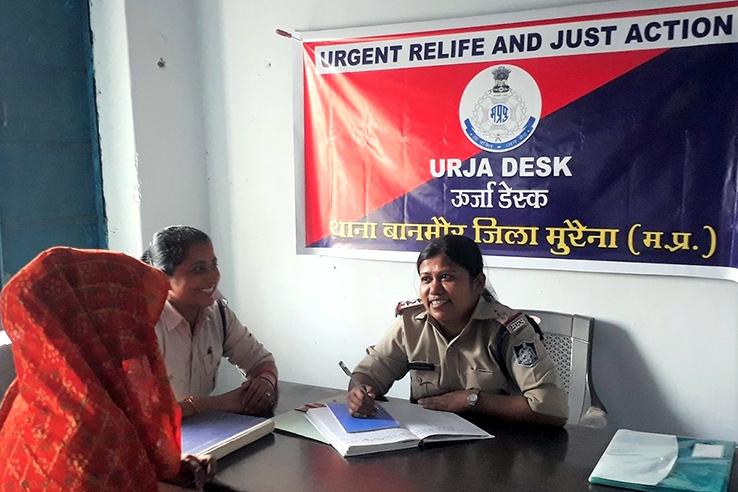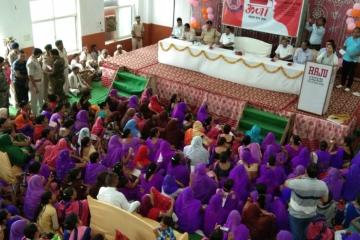
In their own words: Female officers on the front lines of gender-targeted police reforms

Gender-based violence (GBV) is pervasive in India. According to estimates from the World Health Organisation, 35 percent of women in India report having experienced intimate partner violence at least once in their lifetime, compared to the global average of 27 percent. Women in New Delhi were found to compromise upon the quality of their college to have a safer commute, which can lead to poor economic outcomes in the long-run.
Despite these concerning statistics, women may be unwilling to report crimes committed against them to the police for a number of reasons, including social stigma and low levels of trust in the police. Furthermore, the police themselves might be hesitant to lodge women’s complaints, which might further deter survivors of violence from approaching the police.
One potential solution to the underreporting and under-recording of gender-based violence is creating dedicated spaces for women in mixed-gender police stations and training officers to better address and register these crimes. J-PAL affiliated professor Sandip Sukhtankar (University of Virginia) and co-authors, in collaboration with the Madhya Pradesh Police Research and Training Department, conducted a randomised evaluation to test the impact of such gender-targeted police reforms in the state of Madhya Pradesh in India.
The evaluation studied the impact of introducing Women’s Help Desks (WHDs; also referred to as URJA WHDs) into 180 police stations in the state. WHDs are dedicated spaces within police stations to respond to women’s cases. Officers who staffed these help desks received training in registering cases of violence against women, as well as gender sensitisation training, and were supported through routine monitoring and community outreach.
The study was funded primarily by the UK Foreign, Commonwealth & Development Office, awarded through J-PAL's Crime and Violence Initiative, as well as the World Bank’s Sexual Violence Research Initiative, with supplemental funding provided by the University of Virginia’s Center for Global Inquiry and Innovation and the University of Oxford.
Police stations where WHDs were introduced saw a significant increase in the registration of cases related to crimes against women. In these stations, police expressed greater awareness of inadequacies in policing with regard to women’s cases, but, on average, their broader attitudes on gender norms did not appear to shift. The findings of this study have supported the Madhya Pradesh Police’s decision to scale-up the help desks across the state covering 1000 police stations serving over 35 million people. This scale up has been funded in part by ASPIRE and J-PAL’s Innovation in Government Initiative.
Suddhasatwa Bhattacharya, the research manager of this study, reflected that,
“A phenomenal outcome of this intervention was witnessing, through rigorous training, imperceptible but positive differences in hardened beliefs and attitudes. Police officers I’ve spoken to seem to have found a space to question their beliefs without being judged, which eventually reflected in their manner of approaching complainants and female colleagues.”
To better understand the on-ground impacts of the intervention, we spoke with three female police officers who received the training and are currently in charge of the URJA Women’s Help Desks in their respective police stations. In our conversations, the officers shared their perspectives on how the intervention took place on the ground and how it has shaped their day-to-day personal and professional experiences.
Conversations have been edited for clarity

Researchers conducted qualitative research alongside the randomised evaluation to understand the mechanisms through which the intervention led to positive effects. This qualitative research revealed that female officers may have been more receptive to the training component of the intervention, which included manuals to clarify complex legal procedures and alternative routes of accessing the justice system, as well as sensitisation training on how to receive a complainant. In our conversation with Assistant Sub-Inspector Urmila Singh, she reflected:
“After URJA [help desks] were implemented, I feel the scope of counselling and referring women victims to specialised counselling centres has increased. More time and attention is given to the women who come to the thana (station).
Gender sensitization training has taught us to be as sensitive as possible in hearing CAW [crime against women] cases…where I offer a seat to the victim, offer a glass of water, calm her down, and give her time to discuss all that is in her mind.”
The qualitative research conducted by the researchers suggested that alongside changes in how officers respond to female citizens, the intervention also changed the working environment of the stations by mainstreaming gender-responsive policing practices. The help desks were located in mixed-gender police stations, as opposed to women-only stations, which operate on the theory that women victims of violence will be more comfortable to report crimes in the absence of men. The training was delivered to both male and female officers. Researchers hypothesise that the location of the help desks may have increased the attention given to women’s security and ascribing it to ‘routine’ police work. Sub-Inspector Priyanka Rai describes:
“We have a separate room at the station in which we sit and listen to the problems of the victim properly and give her a good environment in which she can discuss her concerns freely.”
The intervention was delivered in two parts. In half of the stations that received WHDs, the help desks were run by female officers only, while in the other half, there were no gender restrictions on the officer running the desk. The randomised evaluation did not find that the intervention changed deep-seated attitudes and beliefs about gender in male police officers. However, Assistant Sub-Inspector Urmila Singh said:
“The male officers [at my station] also speak very openly and politely to women victims after the gender sensitization training.”
The randomised evaluation found that the increase in First Information Reports (FIRs) resulting from the intervention were driven entirely by women-run WHDs. These findings suggest that representation does matter: female officers played a critical role in shaping the impact of the WHDs. The WHD intervention, including training, infrastructure, and other support, may have enabled women to exercise agency in their work. In our conversation with Sub-Inspector Archana Tiwari, she shared:
“After the creation of [the] URJA desk, we were made in-charge of them—which gives us a different confidence and a different identity of our own.”
She further reflected upon the impact of the gender sensitisation training specifically, and how that has shaped her daily life:
“I feel that gender sensitisation training has brought about a change in the mindset of the entire police force...with the help of gender sensitisation program run under the URJA desk, it has become easy for us to work at the police stations, we enjoy working very much, and a family-like environment has been created. Because of this, we can prove to be an asset for the department.”
Increased responsibility has transformed the demeanour of the help desk officers – leaving a lasting impression upon all those who interact with them. Suddhasatwa Bhattacharya, J-PAL South Asia Research Manager, said:
“I remember leaving a police station during a monitoring visit particularly overwhelmed after speaking at length with the help desk officer —a fiercely determined and committed female sub-inspector managing the help desk with limited institutional support, tremendous goodwill, and enthusiasm—the perfect silent advocate for the kind of ecosystem the Madhya Pradesh Police has tried to build for its staff and front-end service consumers through its vision of evidence-based-policing for effecting organisational reforms.”
However, the intervention did not appear to change citizens’ attitudes towards the police and the rates at which women approached the police. Therefore, while this intervention increased the rates of recording crimes against women, barriers to reporting these crimes still remain—and broader interventions, beyond police reforms, might be required to help address this. Long-term and sustained action to support registered cases of gender-based violence through the justice system, alongside larger socio-economic support for women, will be necessary to create systemic changes.


